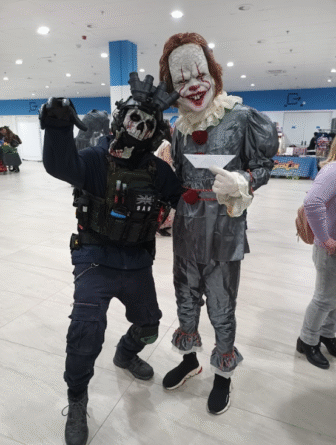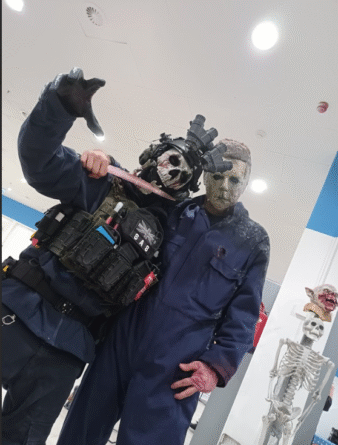Tudom mit tettél idén október ötödikén… ott voltál te is a Lurdy Házban, Magyarország egyetlen igazi horror találkozóján. Ha mégsem, akkor bizony életed leghátborzongatóbb hibáját követted el, mert mi ott voltunk, rettegtünk, és imádtuk!

Idén már második alkalommal került megrendezésre a GeekCon Hungary és a Halloween Itthon szervezésében az év legnagyobb félelem fesztiválja, a Halloween HorrorCon. Nekünk is ez volt a Végső Állomás a héten, magunkra kaptuk a Libabőr-t és bejártuk a különleges eseményt.
Az őszi időszak jellemzője manapság, hogy kis hazánkban is egyre inkább meghonosodik a kelta hagyományi körből eredő Halloween ünnepe.

Nem tévesztendő össze a keresztény ünnepnappal a Mindenszentekkel, mert még előbbit november elsején tartják, úgy All-Hallows-Eve, ennek előestéjére, október utolsó napjára esik.
Ez volt Samhain, a téli sötétség kezdete, a kelta újév, az aratásért való hála ünnepe.

Úgy hitték, az előző évben elhunytak lelkei ezen az éjjelen vándorolnak át a holtak birodalmába, így a két világ közti határ elmosódik, némelyek visszatérnek a túlvilágról s e bolygó lelkek az élőket néha huncutul összezavarják. Az emberek emiatt lámpásokat gyújtottak, maskarákat öltöttek, hogy megtévesszék az esetleg ártó szándékú, vagy tréfálkozni vágyó szellemeket. Játékokat játszottak, örültek a bőségnek és babonás szokásoknak hódoltak.
Így fonódott össze szépen lassan, népeken és évszázadokon keresztül, a pogány hitvilágból eredő hagyomány és a nyüzsgő modern popkultúra számos eleme. Ez lett a mai beöltözős buli, ahol az a győztes, aki a legijesztőbb rémpofát pingálja magára, mert bizony azóta változott viszonyunk a “rémisztővel” és jóformán szubkultúra alakult a félelem köré. Ennek csodás egyvelegét tárta elénk a Halloween HorrorCon, az idei legnagyobb elő halloween party és horror kiállítás.

Ebben az évben már a Ludry Ház hatalmas rendezvény központjában bontakozott ki e cukorka körítéses vámpírok bálja, közel háromezer négyzetméteren keresztül szövögetve pókhálóit a gyanútlan nézelődők köré.
Nem csak Halloween témával érkeztek a kiállítók és vásározók, valódi horror éden épült fel itt, ezen az álmos őszi vasárnapon, hogy minden sarkon és standon valami tutira a frászt hozza ránk.
Először sikítottunk örömünkben, hogy itt lehetünk és valódi tökünnep rajongóként végre magunkba ihatjuk a pumpkin spice illatgyertyák bódító aromáit. Aztán sikoltottunk ijedtünkben, mert a legmélyebb félelmeink is ránk találtak a változatos kínálattal tele halmozott asztalok között. Végül maga a Sikoly jött szembe velünk, mert hogyan is hagyhatta volna ki ezt a bulit egy ilyen gyilkos klasszikus?

Természetesen a horror és Halloween tökéletes találkozása Mike Myers sem volt rest megmutatni magát a rendezvényen, és kérésre bárkit szívesen megkéselt egy jól sikerült fotó erejéig.
Mészarosaink pengéin még ki sem hűltek színpadias művér foltjaink, már felbukkant Freddy Krueger is több változatban, hogy napunkat rémálommá változtassa a Könyves Kálmán körúton. Közben többfelé elharapódzott a buli, mert a vámpírok sem bírtak magukkal ennyi lüktető élet közepette, szüntelen babonázták a vérfarkasokkal viaskodó vendégeket. Mi sikkesen arrébb táncoltuk magunkat az élőholtak közt a Thriller örökzöld dallamaira, és menthetetlenül lebegtünk bele a borzongásba akkor is, ha nem fogadtuk el AZ-tól a piros léggömböt.
Megpróbáltuk lerázni Jason Voorhees-t is a vásártéri kavalkádban, csak hogy aztán belefussunk A nyolcadik utas-ba a következő sarkon..és ha nem éreztük magunkat eddig is kellően Démonok között, hát persze hogy pont arra sétált a Kaszás, az igazi díszvendég, és innentől kezdve, mint egy rossz Ómen járt nyomukban bókolva, hogy milyen Jól áll nekünk a halál. Mi pedig kétségbeesve kerestük Constantine-t, de legalábbis egy valamire való Ördögűző-t. A javasasszony sátránál kértük a Boszorkányok-at vegyék le rólunk a rontást, csak hogy ismét a vérgőzös zsibvásárban találjuk magukat egy bájital bevásárló listájával.

Ha már itt végeztük, és tartottunk tőle, be is végezzük ennyi sorozatos gyilkos közt, beszereztünk pár szívünknek kedves szuvenírt és kabalát, remélve hogy megvédelmeznek minket a továbbiakban.
Rémségek kicsiny boltja várt minket mindenfelé, hogy felfedezzük kínálatukat. Az elhatalmasodó iszonyat közepette, igazán jól esett az árusok kedvessége, mindenhol kaptunk cukorkát, így nem kellett csínyekhez folyamodnunk.
A kiállítók közt volt igazi Halloween hangulatú miniatűr város, beállhattunk fotózni rémisztően berendezett enteriőrökbe és többfelé találhattunk örökmozgó animált díszleteket és bábukat. Vásárolhattunk hangulatos vagy egyenesen vérfagyasztó dekorációt otthonainkba, felicomázhattuk magunkat a ‘leggótabb’ ékszerkülönlegességekkel, beszerezhettünk számos kiegészítőt és kelléket jelmezeinkez.
Mire a védelmező feszületektől és fokhagyma szagtól már éppen ránk jött a Szédülés, elfogytak a standok és egy új világba űzött minket az ijedtség.

Külön teremben kaptak helyet a regényes rémségek. Itt a végtelenségig válogathattunk a borzongató irományok közt, legyen az könyv, novelláskötet, gótikus horror sztori, science fiction hideglelés az űr sötétjéből, vagy képregények a kendvenc főgonoszainkkal.

Magyar alkotók kiadványait is magunkévá tehettük a regények közt válogatva, tudományos fantasztikust, klasszikus horror történetet és igazi brutális gyilkolászást kínálnak közös kötetben.

Ezen a részlegen megtalálhatták a maguk ízlését a true crime műfaj rajongói is, és a helyszínen beregisztrálva át is vehették első akta csomagjukat a megoldatlan bűntényeket kinyomozni vágyók. Mint megtudtuk, ez egy nemrég indult játék, ahol a hideg nyomon hagyott ügyeket göngyölíthetik fel a vállalkozó szelleműek.

Összefutottunk az első hazai alkotók által készülő antihőssel is, Imposztor-ral, akinek kalandjai klasszikus képregény formátumban bontakoznak ki az érdeklődők előtt.

A vetekedni vágyók résztvehettek egy különleges szinkron bajnokságon is, hogy kipróbálják magukat kedvenceik helyében és alámondják, vagy épp sikítozzák legendás jelenetiket és filmrészleteiket.

Vérfagyasztó jelmezverseny is akadt, hiszen hogy is maradhatott volna ki ez a program éppen Halloween kapcsán. Hát csoda hogy ennyi rémség kergetett be minket a nagyterembe? ..ahol nem kevésbé hűlt meg ereinkben a vér a jóformán profi színvonalon teljesítő versengőktől.

Szerencsére a nézőtéren megpihenve akadt valamivel nyugtatóbb program is, például szinkronszínészek és táncosok, kihagyhatatlan tombola, de meghallgathattunk több panelbeszélgeszélgetést is a borzongatás anatómiájáról és ijesztgetés művészetéről.

Az este hét órai zárás szinte korainak tűnt egy ilyen balzsamos októberi éjjelen, viszont így is sikoltozástól rekedten és futástól kifulladva menekültünk haza. Persze csakis azért, hogy életben maradjunk és legközelebb is jöhessünk…amennyiben előbbi mégsem sikerült, úgy jövőre mi leszünk a zombik, mert mindenképpen itt leszünk.

Köszönjük az élményt, találkozunk jövőre!

